Parameter Optimization Design of Power-Cycling Hydrodynamic Mechanical Transmission Based on Output Capacity Characteristics
Abstract
1. Introduction
2. Analysis of Output Capacity Characteristics of PCHMT
3. Construction of Typical Loading–Hauling Cycle for the Loader
3.1. Data Acquisition
3.2. Processing and Transformation of Experimental Data
3.3. K-Means Clustering of Operational Data
- For the speed blocks, average speed vmean, maximum speed vmax, and travel distance s.
- For the travel resistance blocks, the average travel resistance Ftramean, maximum travel resistance Ftramax, and integral sum of the travel resistance Ftraint.
- For the hydraulic resistance torque blocks, the average hydraulic resistance torque Thrtmean, the maximum hydraulic resistance torque Thrtmax, and the integral sum of the hydraulic resistance torque Thrtint.
- (1)
- The sum of the distances between all cluster centers was less than or equal to the difference Dk between the maximum and minimum values of the sample data;
- (2)
- The distance between any two cluster centers was greater than or equal to a predefined threshold dt, where the product of dt and the number of clusters was less than or equal to Dk.
- Forward digging operation;
- Loaded reverse operation;
- Loaded travel to truck operation;
- Empty return operation.
3.4. Synthesis of the Typical Loading–Hauling Cycle
4. Parameter Optimization Design for the PCHMT
4.1. Definition of the Optimization Problem
4.2. Implicit Constraints on Design Variables
4.3. Optimization Problem Solving Method
4.4. Analysis of Optimization Results
5. Simulation Verification
6. Conclusions
- (1)
- The traditional forward parameter design method, which proceeds sequentially from the engine to the transmission and then to the wheels, determines the structural parameters based solely on the speed ratio–efficiency relationship. However, this approach cannot ensure higher transmission efficiency under identical load conditions, thereby underscoring the necessity of a design methodology based on output capacity characteristics.
- (2)
- Using the K-means clustering algorithm, a typical loading–hauling cycle was constructed for the loader. This representative cycle captures the essential operating characteristics of the machine and provides a reliable basis for parameter and control system design.
- (3)
- A comparative analysis of fuel consumption and transmission efficiency under optimal and non-optimal parameter conditions revealed that, although the transmission efficiency of the optimal parameters was lower, fuel economy improved by 2.6%. This demonstrates that the optimized parameters effectively enhance overall loader performance and can be applied to guide future transmission design.
Author Contributions
Funding
Data Availability Statement
Acknowledgments
Conflicts of Interest
Abbreviations
| i | Speed ratio |
| K | Torque ratio |
| η | Efficiency |
| T | Torque |
| n | Rotational speed |
| λp | Input torque coefficient of the torque converter |
| α | Speed ratio of the planetary gear set |
| D | Diameter of the torque converter |
| ρ | Density of the working fluid |
| in | Input |
| out | Output |
| λPCHMT,in | Input torque coefficient of the PCHMT |
| CPCHMT,out | Output capacity coefficient of the PCHMT |
| Ftra | Travel resistance of the wheel loader |
| Tb | Braking torque of the wheel loader |
| vveh | Vehicle speed |
| rwh | Wheel radius |
| m | Loader mass |
| Tpu | Input torque of the hydraulic pump |
| Ppu | Outlet pressure the hydraulic pump |
| qpu | Displacement the hydraulic pump |
| ηpu | Efficiency the hydraulic pump |
| Tp,tot | Total hydraulic resistance torque |
| Twp | Input torque of the hydraulic pump for the implement system |
| Ttp, | Input torque of the hydraulic pump for the steering system |
| Tbp | Input torque of the hydraulic pump for the braking system |
| rty | Correlation coefficient between a feature parameter and fuel consumption |
| ttot | Total duration of the typical loading–hauling cycle |
| tsa | Ratio of the effective signal acquisition time |
| Nwc | The number of effective working cycles |
| icad,1 | First-stage speed ratio of the capacity regulation device |
| βp | Impeller exit angle |
| βs | Stator exit angle |
| Teng | The torque on the engine external characteristic curve |
| neng | Engine speed |
| Ftrc,max | Maximum traction force of the loader |
| φ | Ground adhesion coefficient |
| fr | Rolling resistance coefficient |
| PCHMT | Power-cycling hydrodynamic mechanical transmission |
| TC | Torque converter |
| cad | Capacity adjustment device |
| pgs/PGS | Planetary gear set |
| frgm | Fixed-ratio gear mechanism |
| rt | Range transmission |
| fd | Final drive |
| wr | Wheel reducer |
References
- Ma, W.; Xie, D.; Wang, Z.; Ran, Z.; Liu, C.; Wang, S. Modeling, calculation, and analysis of torsional vibration characteristics of the hydrodynamic transmission system in engineering vehicle. Proc. Inst. Mech. Eng. Part D J. Automob. Eng. 2022, 236, 1824–1839. [Google Scholar] [CrossRef]
- Xia, G.; Gao, J.; Tang, X.; Wang, S.; Sun, B. Control strategy for shift schedule correction based on driving habits for vehicles with automatic transmission. Int. J. Automot. Technol. 2020, 21, 407–418. [Google Scholar] [CrossRef]
- Wang, H.; Sun, D.; Qin, D. A new continuously variable transmission system applied to transmission system of the roadheader’s cutting unit. Proc. Inst. Mech. Eng. Part C J. Mech. Eng. Sci. 2017, 231, 3590–3600. [Google Scholar] [CrossRef]
- Zhang, Z.; Wang, H.; Ge, S.; Li, M. Torsional vibration analysis of a powertrain with a power reflux hydraulic transmission system. J. Vibroeng. 2022, 24, 405–415. [Google Scholar] [CrossRef]
- Yu, J.; Song, Y.; Zhang, H.; Dong, X. Novel design of compound coupled hydro-mechanical transmission on heavy-duty vehicle for energy recycling. Energy 2022, 239, 122291. [Google Scholar] [CrossRef]
- Kwon, K.; Lee, J.; Lim, S. Optimization of multi-speed transmission for electric vehicles based on electrical and mechanical efficiency analysis. Appl. Energy 2023, 342, 121203. [Google Scholar] [CrossRef]
- Banerjee, J.; Adibi asl, H.; Lashgarian, A.N.; McPhee, J. Parametric importance analysis and design optimization of a torque con verter model using sensitivity information. SAE Int. J. Passeng. Cars Mech. Syst. 2012, 5, 621–638. [Google Scholar] [CrossRef]
- Kawashima, K.; Endo, M. Development of a Compact and High-Performance Torque Converter Based on a New Parameter Sensitivity Mapping; Search Technical Paper; SAE International: Detroit, MI, USA, 2019. [Google Scholar]
- Kesy, A.; Kadziela, A. Construction optimization of hydrodynamic torque converter with application of genetic algorithm. Arch. Civ. Mech. Eng. 2011, 11, 905–920. [Google Scholar] [CrossRef]
- Xiong, P.; Chen, X.; Sun, H.; Zhong, J.; Wu, L.; Gao, H. Effect of the blade shaped by Joukowsky airfoil transformation on the characteristics of the torque converter. Proc. Inst. Mech. Eng. Part D J. Automob. Eng. 2021, 235, 3314–3321. [Google Scholar] [CrossRef]
- Li, C.; Meng, F.; Xi, J.; Zhai, Y. Starting shift control of heavy-duty automatic transmissions based on the optimal trajectory of turbine speed. Mech. Syst. Signal Process. 2019, 126, 490–504. [Google Scholar] [CrossRef]
- Yang, W.; Xiao, X. Design and analysis of mechanisms of 7-, 8- and 9-speed automatic transmissions for vehicle powertrains. Energies 2023, 16, 7402. [Google Scholar] [CrossRef]
- You, Y.; Sun, D.; Qin, D. Research on vehicle starting control based on reflux power condition. Mech. Mach. Theory 2019, 134, 289–307. [Google Scholar] [CrossRef]
- Wang, H.; Sun, D. Optimal matching between a diesel engine and a PRHTS transmission. J. Braz. Soc. Mech. Sci. Eng. 2017, 39, 3375–3387. [Google Scholar] [CrossRef]
- Kan, Y.; Xie, S.; Yin, Q.; Jiang, W.; Yang, M.; Qian, R. Dynamic power matching for wheel loader based on power reflux hydrodynamic transmission system. Proc. Inst. Mech. Eng. Part D J. Automob. Eng. 2025, 239, 4403–4417. [Google Scholar] [CrossRef]
- Kan, Y.; Sun, D.; Luo, Y.; Ma, K.; Shi, J. Optimal design of power matching for wheel loader based on power reflux hydraulic transmission system. Mech. Mach. Theory 2019, 142, 103600. [Google Scholar] [CrossRef]
- Naunheimer, H.; Bertsche, B.; Ryborz, J.; Novak, W.; Fietkau, P. Automotive Transmissions: Fundamentals, Selection, Design and Application; Springer: Berlin/Heidelberg, Germany, 2011. [Google Scholar]
- Molokomme, D.N.; Chabalala, C.S.; Bokoro, P.N. Enhancement of advanced metering infrastructure performance using unsupervised k-means clustering algorithm. Energies 2021, 14, 2732. [Google Scholar] [CrossRef]
- Gabana, P.; Giménez, B.; Melgar, A.; Horrillo, A. Adaptive polynomial filter applied to in-cylinder pressure signal in internal combustion engines. Mech. Syst. Signal Process. 2025, 235, 112871. [Google Scholar] [CrossRef]
- Xu, S.; Su, Z.; Hao, J.; Liu, Z. High-frequency noise suppression method for active magnetic bearings using the steady state Kalman filter. J. Mech. Sci. Technol. 2025, 39, 2519–2530. [Google Scholar] [CrossRef]
- Qin, D.; Zhan, S.; Qi, Z.; Chen, S. Driving cycle construction using K-means clustering method. J. Jilin Univ. 2016, 46, 384–389. [Google Scholar] [CrossRef]
- Meng, F.; Tao, G.; Chen, H. Smooth shift control of an automatic transmission for heavy-duty vehicles. Neurocomputing 2015, 39, 197–206. [Google Scholar] [CrossRef]
- Wang, F.; Wu, Z.; Xu, B.; Fiebig, W. A mode-driven control strategy to reduce electric drive peak power of hybrid wheel loader propulsion system. IEEE Trans. Veh. Technol. 2023, 72, 5948–5961. [Google Scholar] [CrossRef]
- Shi, Q.; Qiu, D.; Zhou, J. Driving cycle construction and accuracy analysis based on combined clustering technique. Automot. Eng. 2012, 34, 164–169+158. (In Chinese) [Google Scholar]
- Lei, J.; Yang, C.; Ren, C.; Li, W.; Liu, C.; Sun, A.; Liu, Y.; Chen, Z.; Yu, T. Development and validation of a deep learning-based model for predicting burnup nuclide density. Int. J. Energ. Res. 2022, 46, 21257–21265. [Google Scholar] [CrossRef]
- Liu, X.; Sun, D. An improved design of power-cycling hydrodynamic mechanical transmission. J. Mech. Sci. Technol. 2020, 34, 3165–3179. [Google Scholar] [CrossRef]
- Yu, Z. Automobile Theory, 6th ed.; China Machine Press: Beijing, China, 2024. (In Chinese) [Google Scholar]
- Xu, Y.; Zhang, H.; Yang, Y.; Zhang, J.; Yang, F.; Yan, D.; Yang, H.; Wang, Y. Optimization of energy management strategy for extended range electric vehicles using multi-island genetic algorithm. J. Energy Storage 2023, 61, 106802. [Google Scholar] [CrossRef]
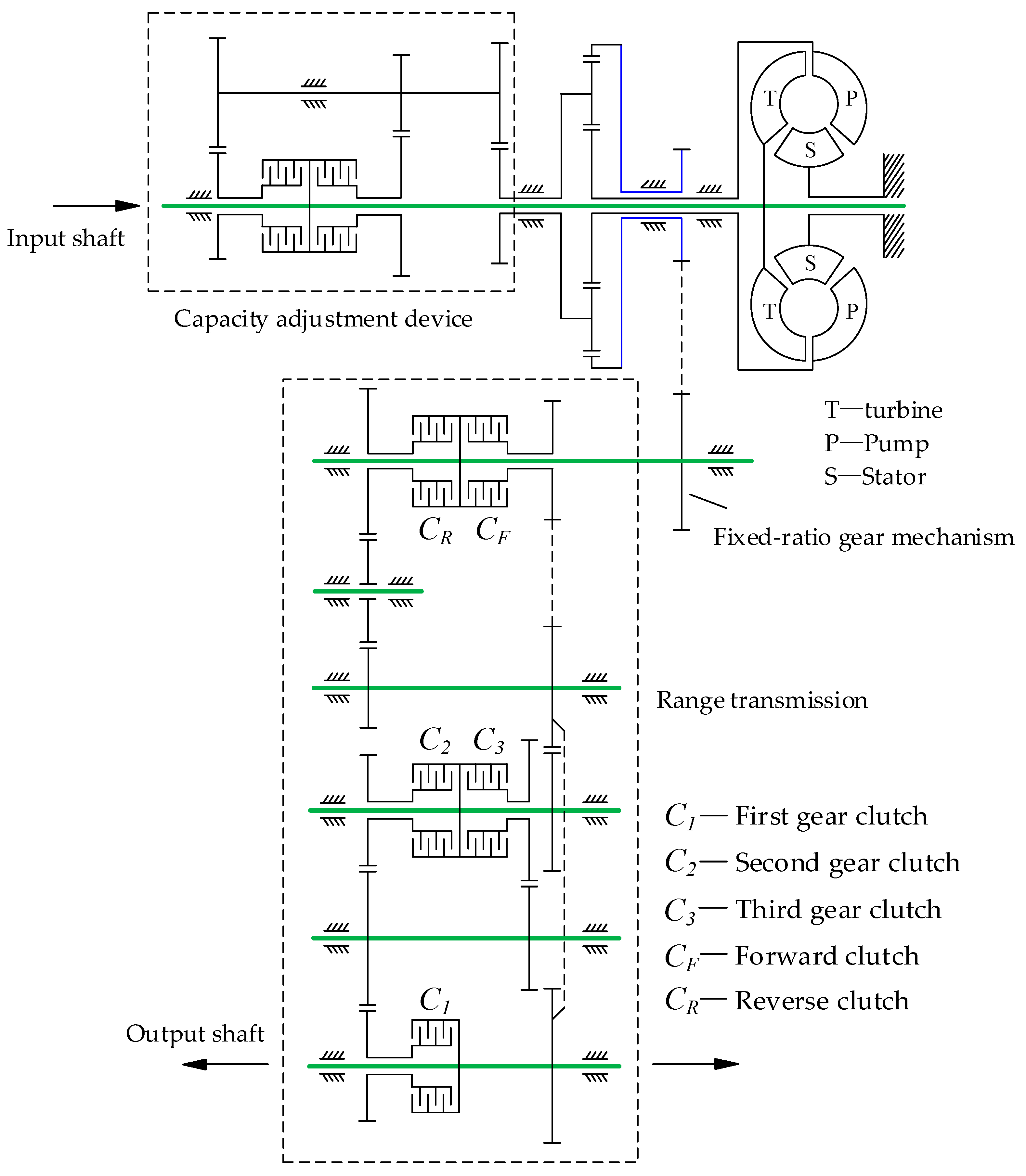
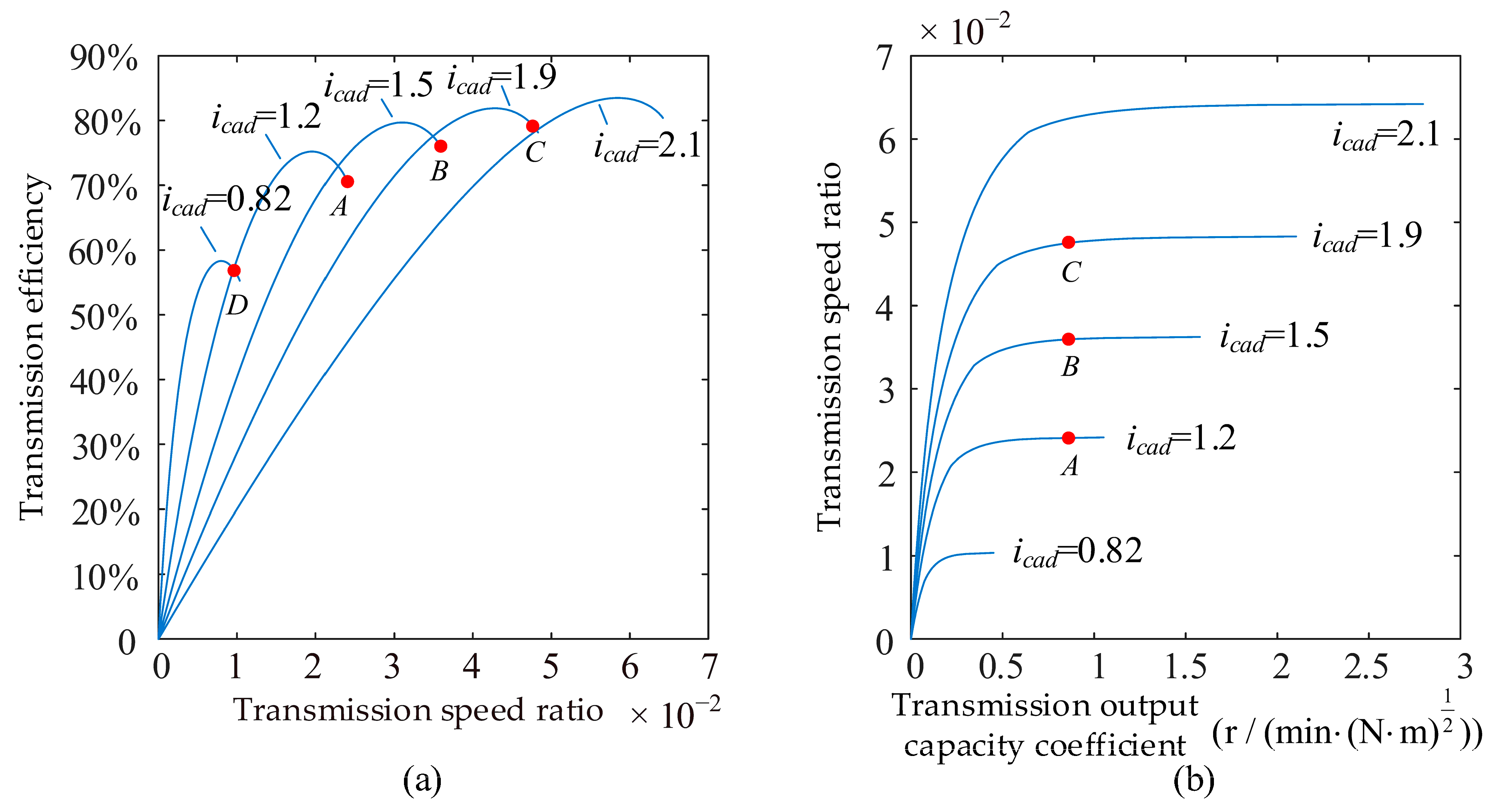
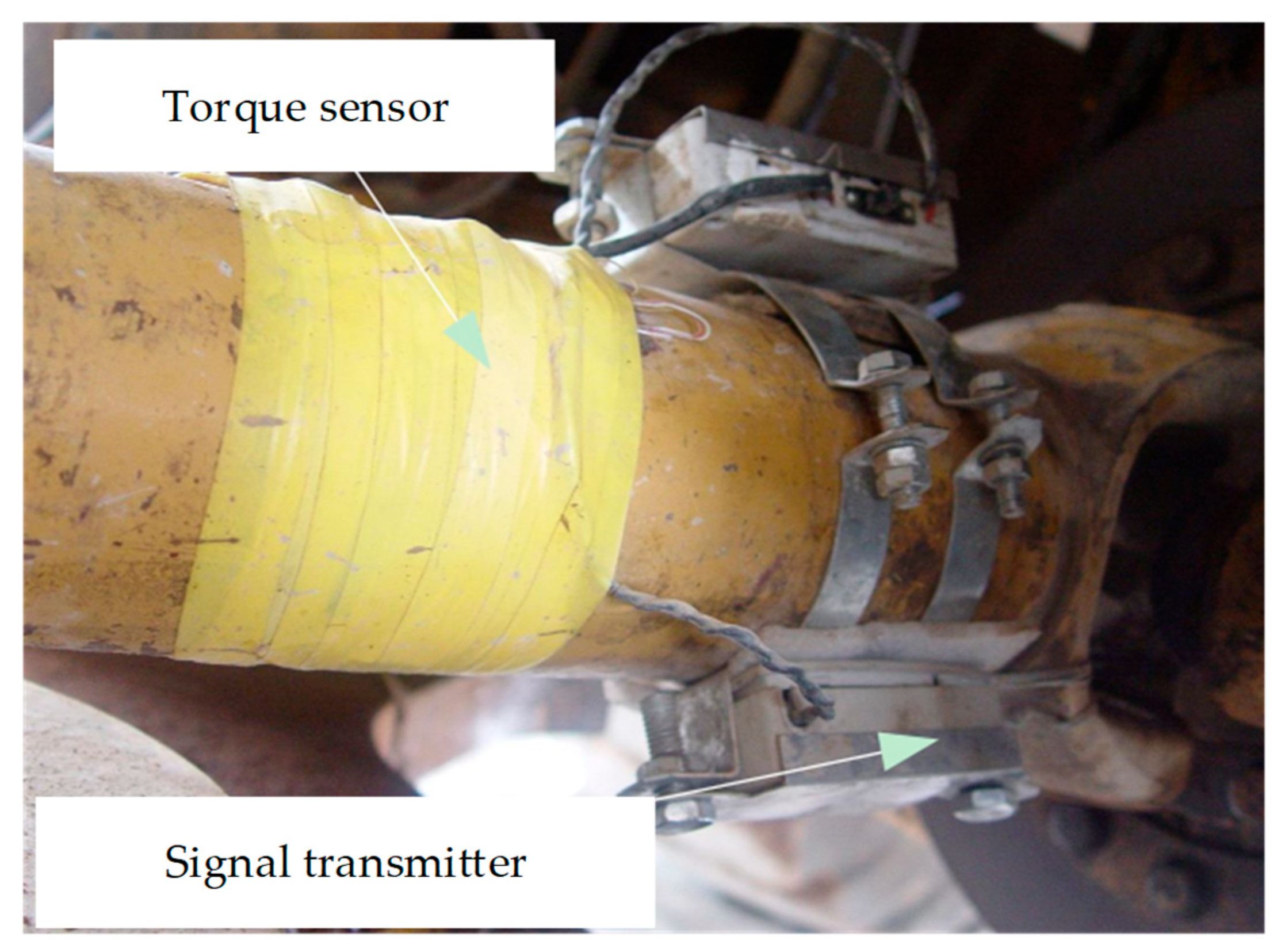
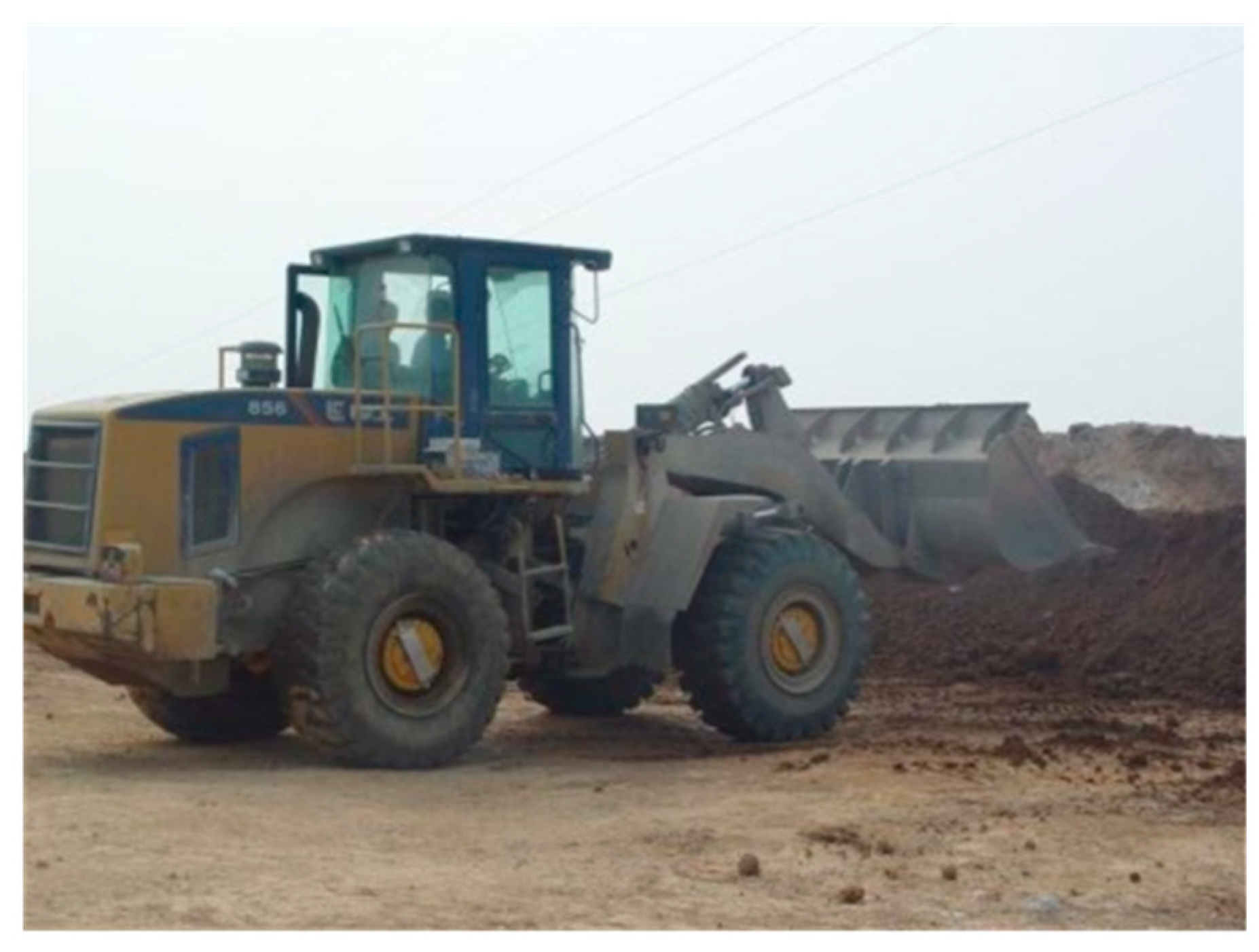
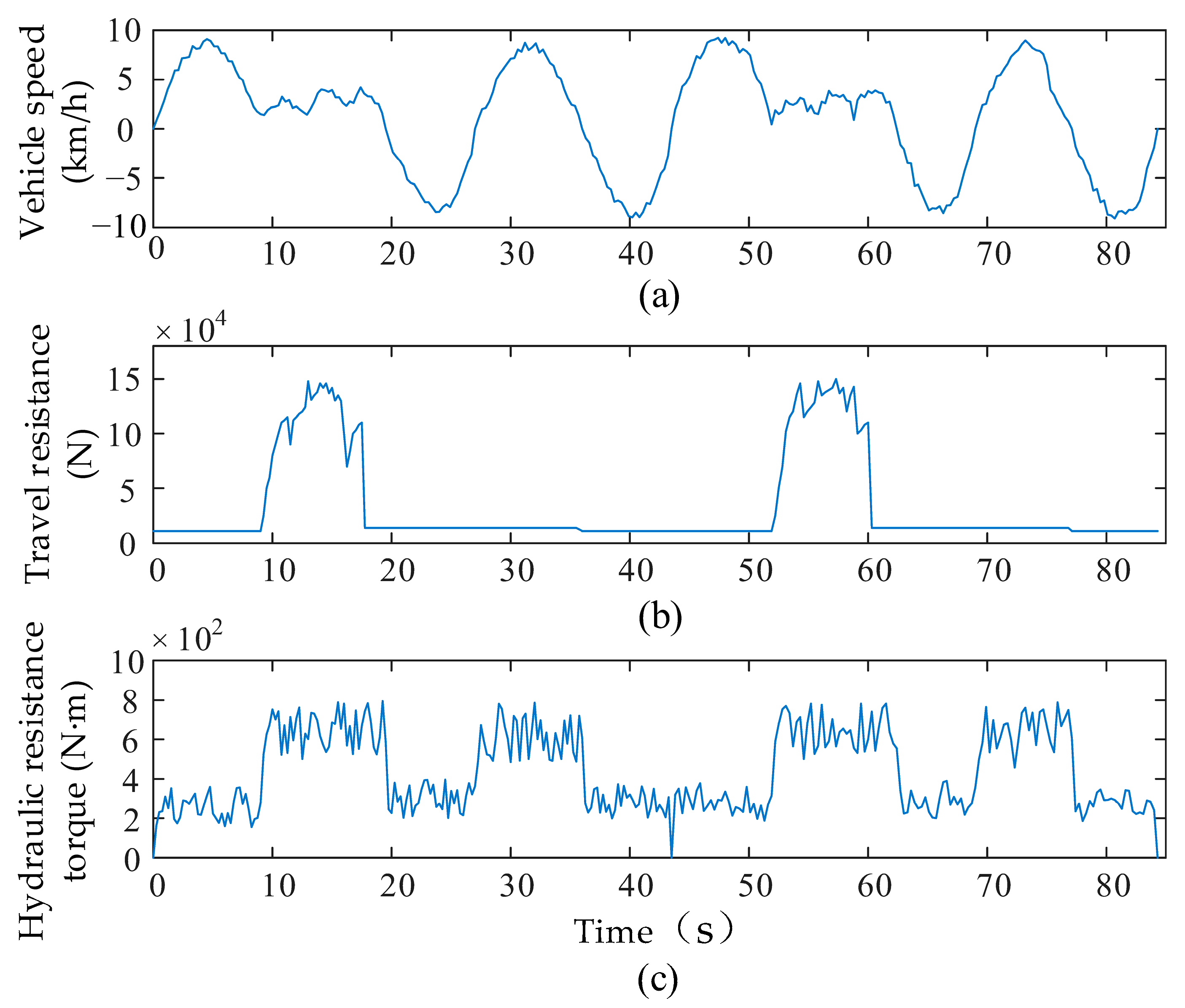
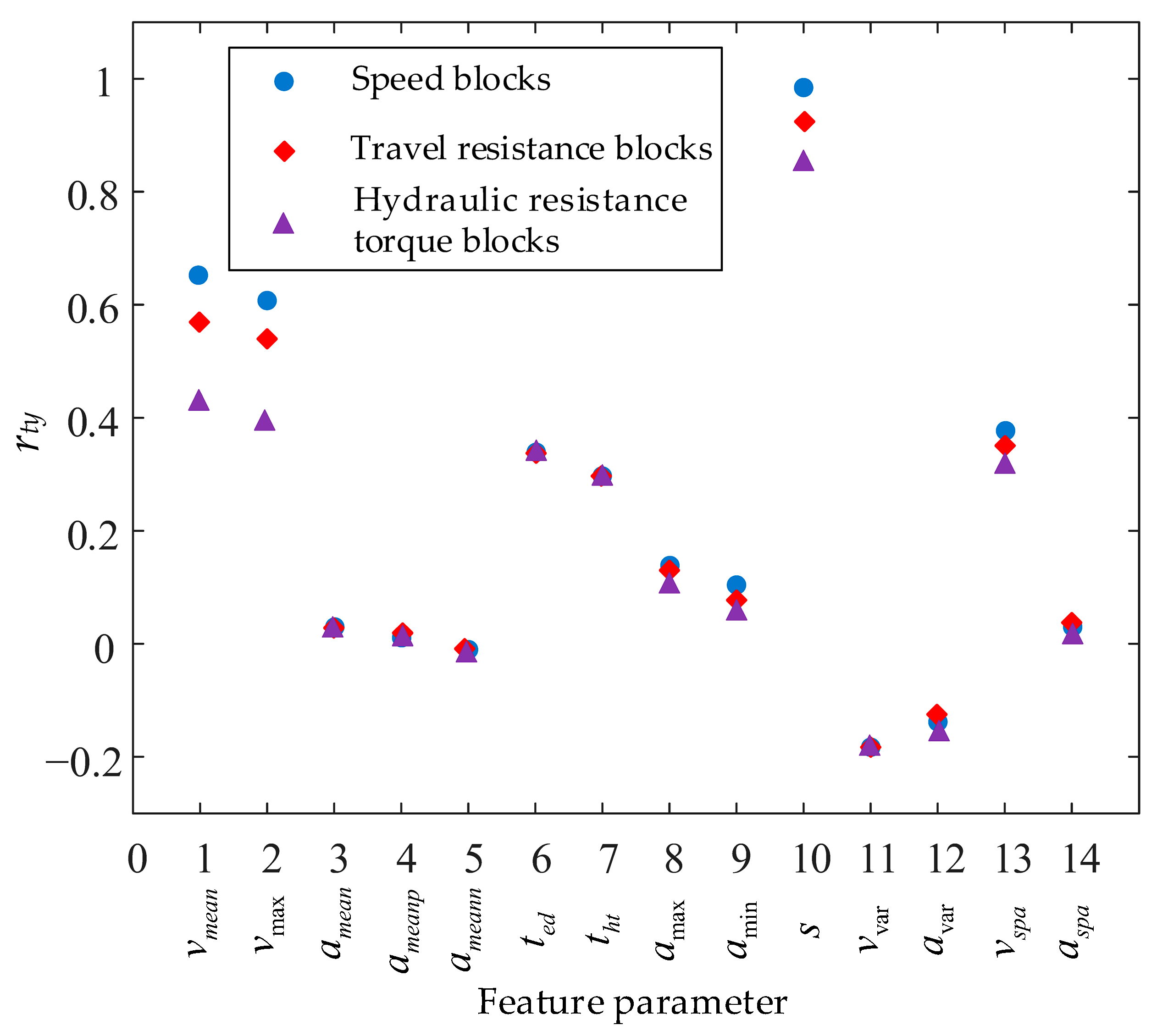
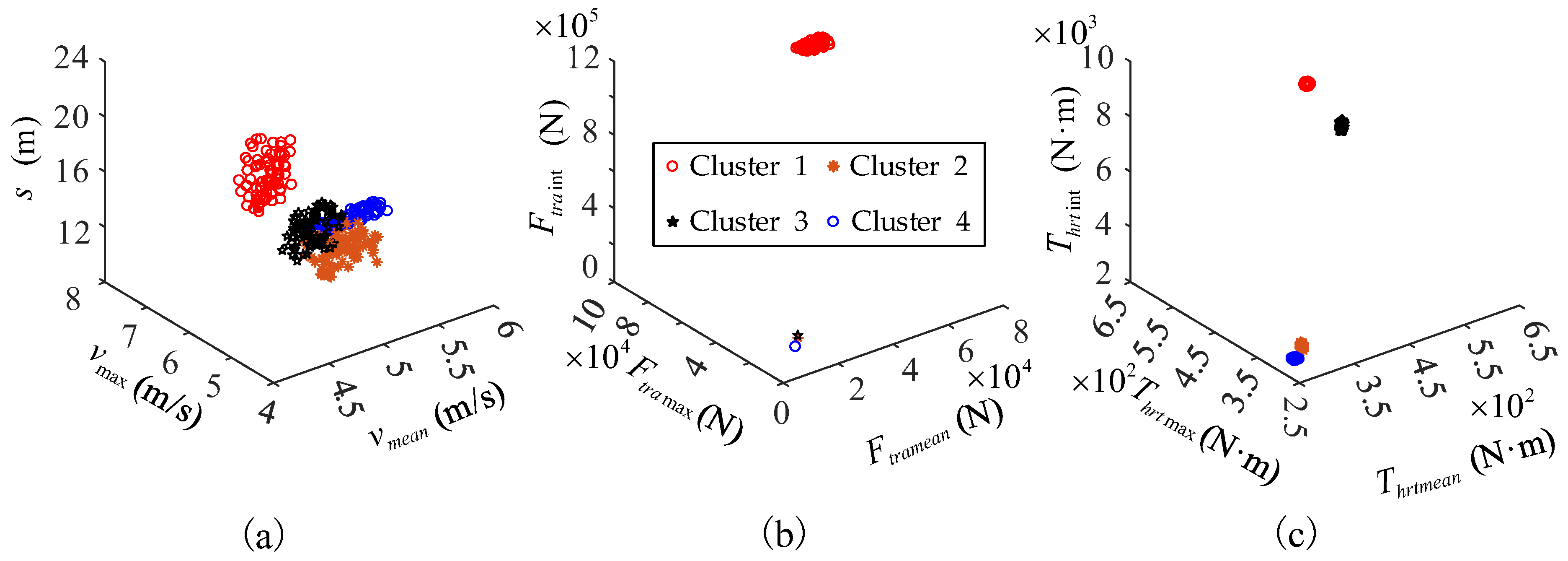
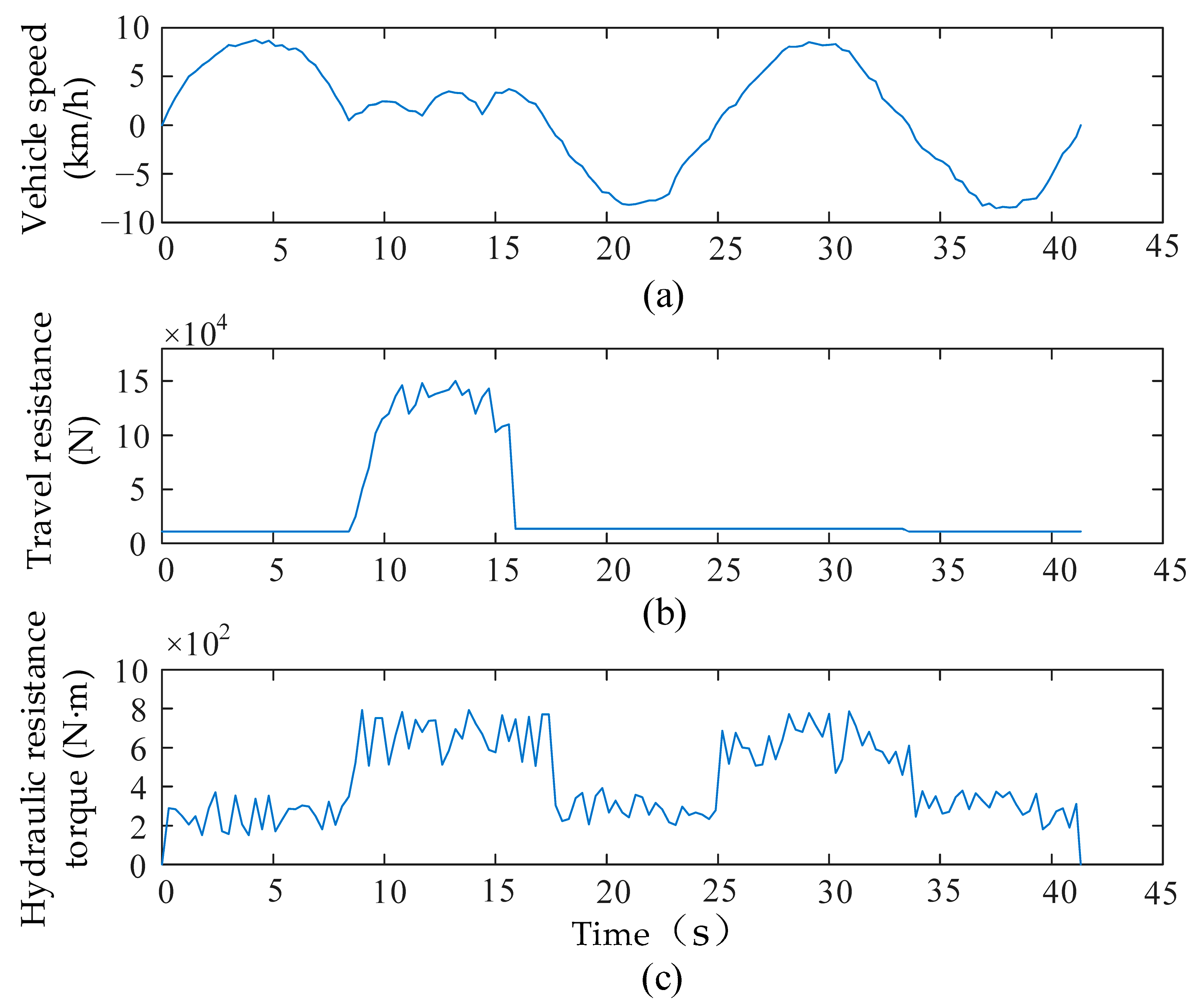
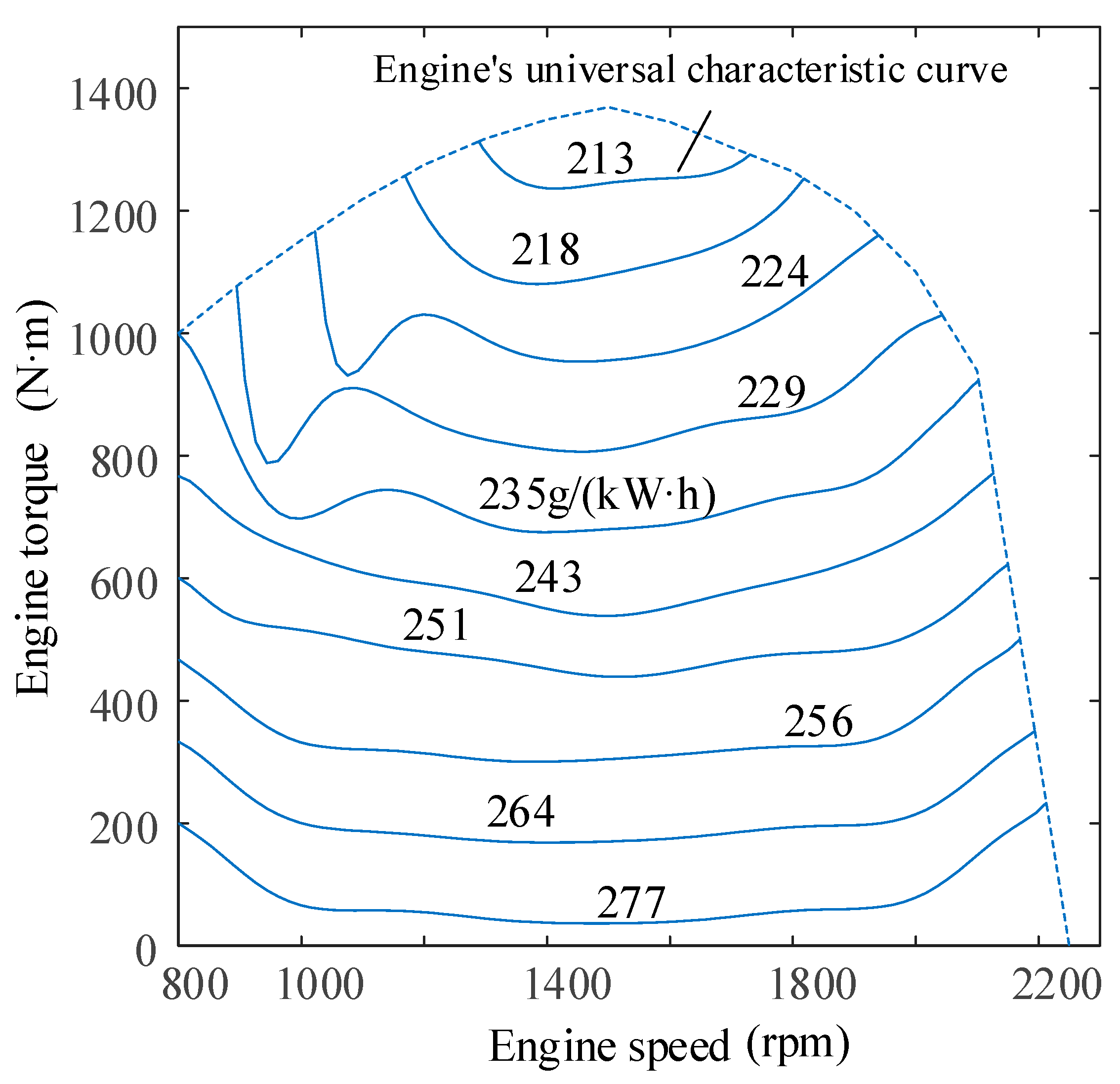
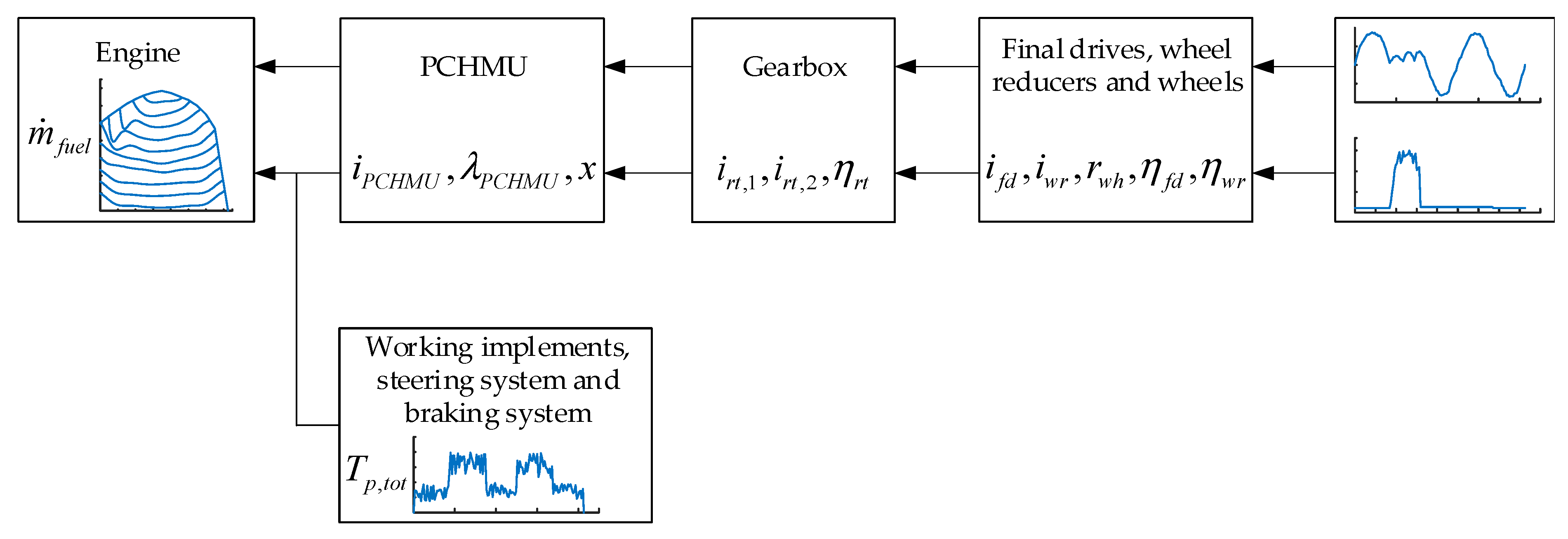
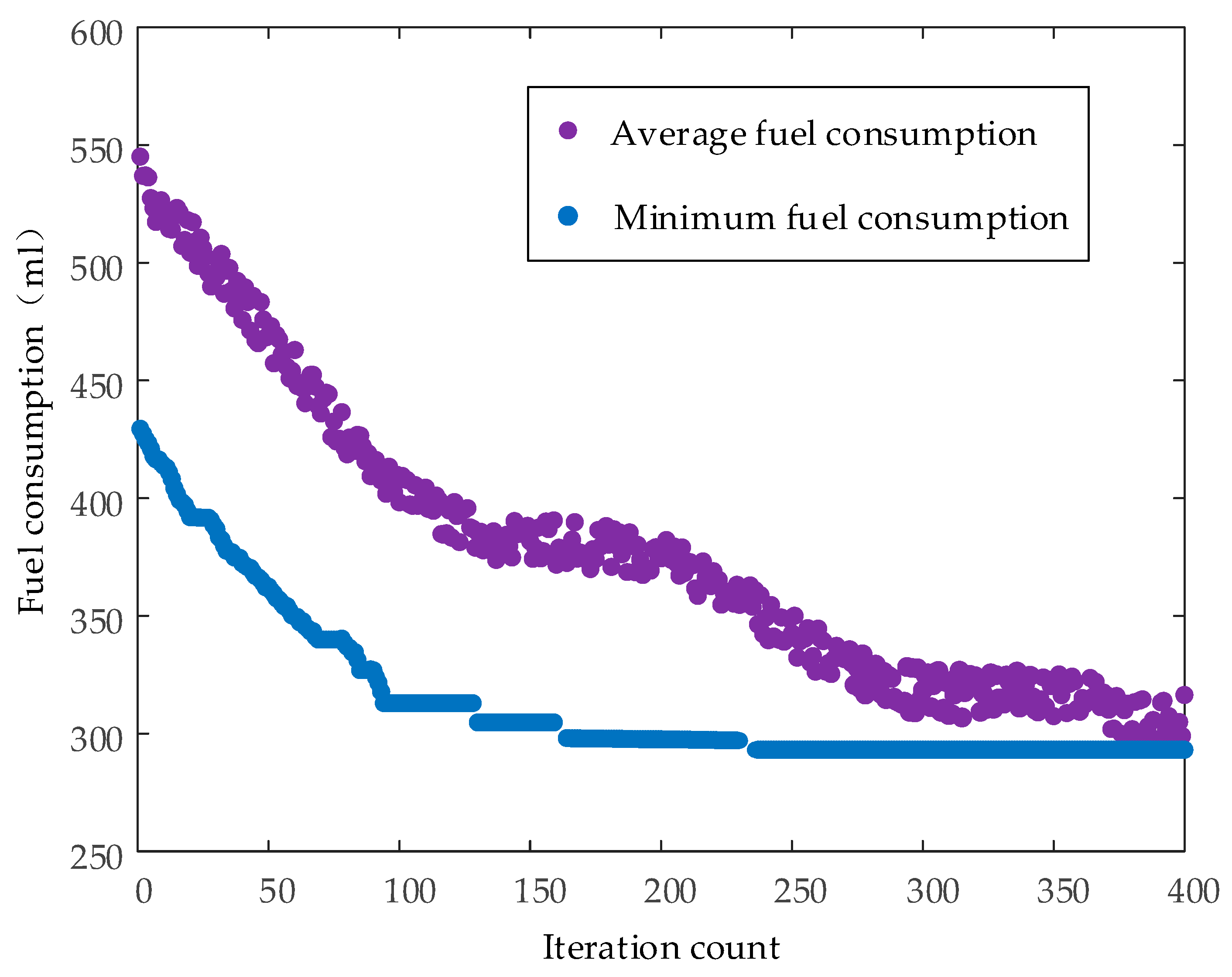
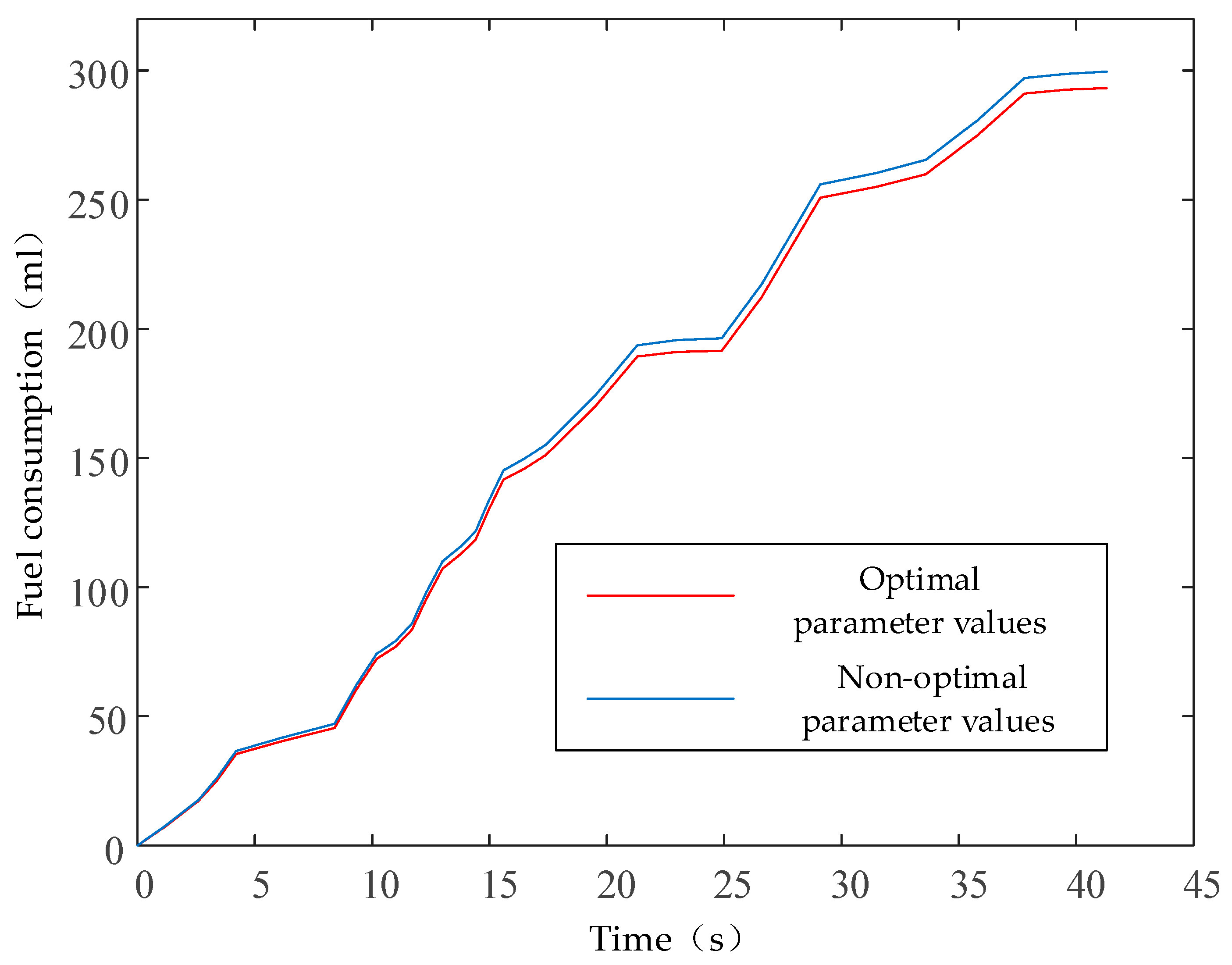
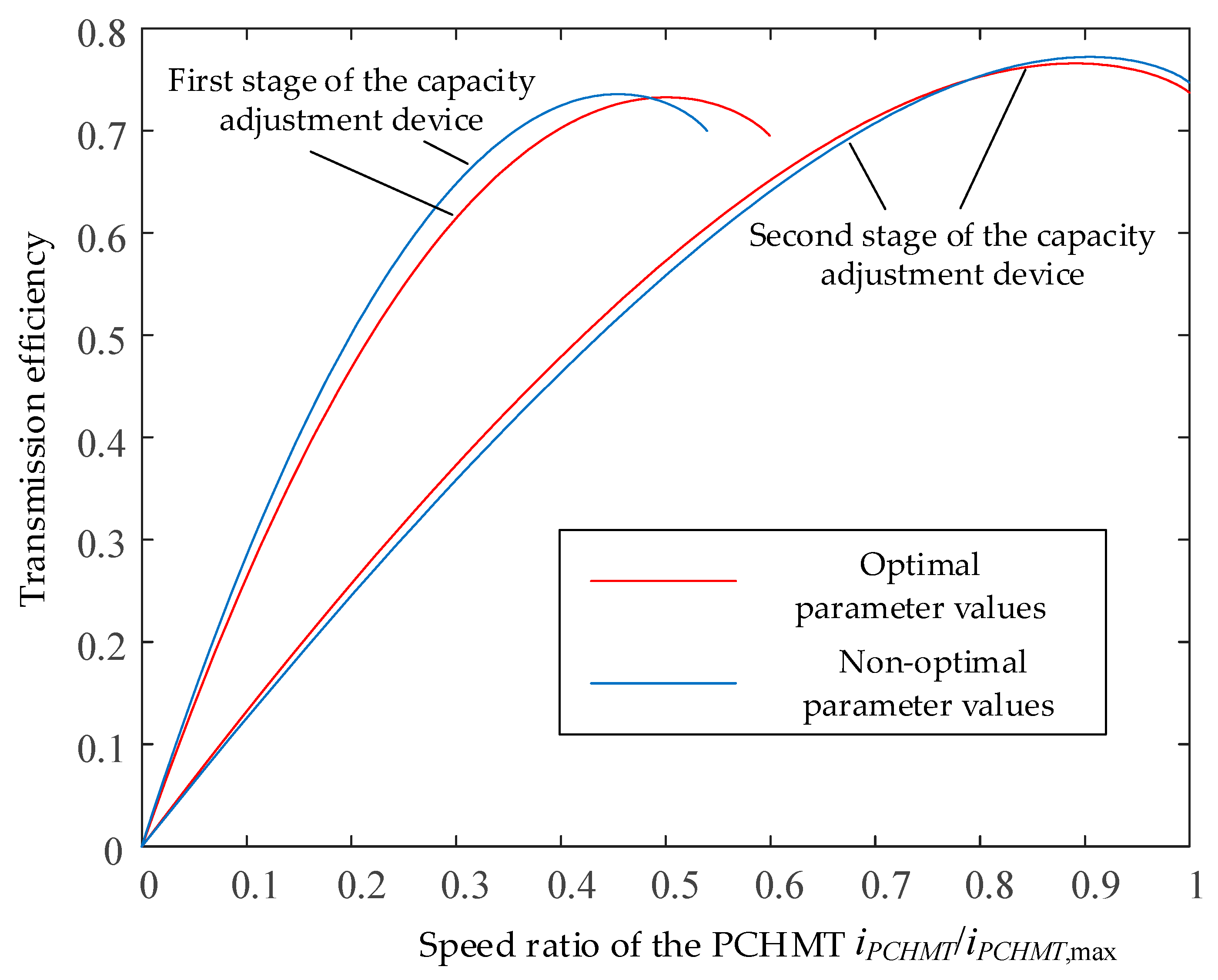
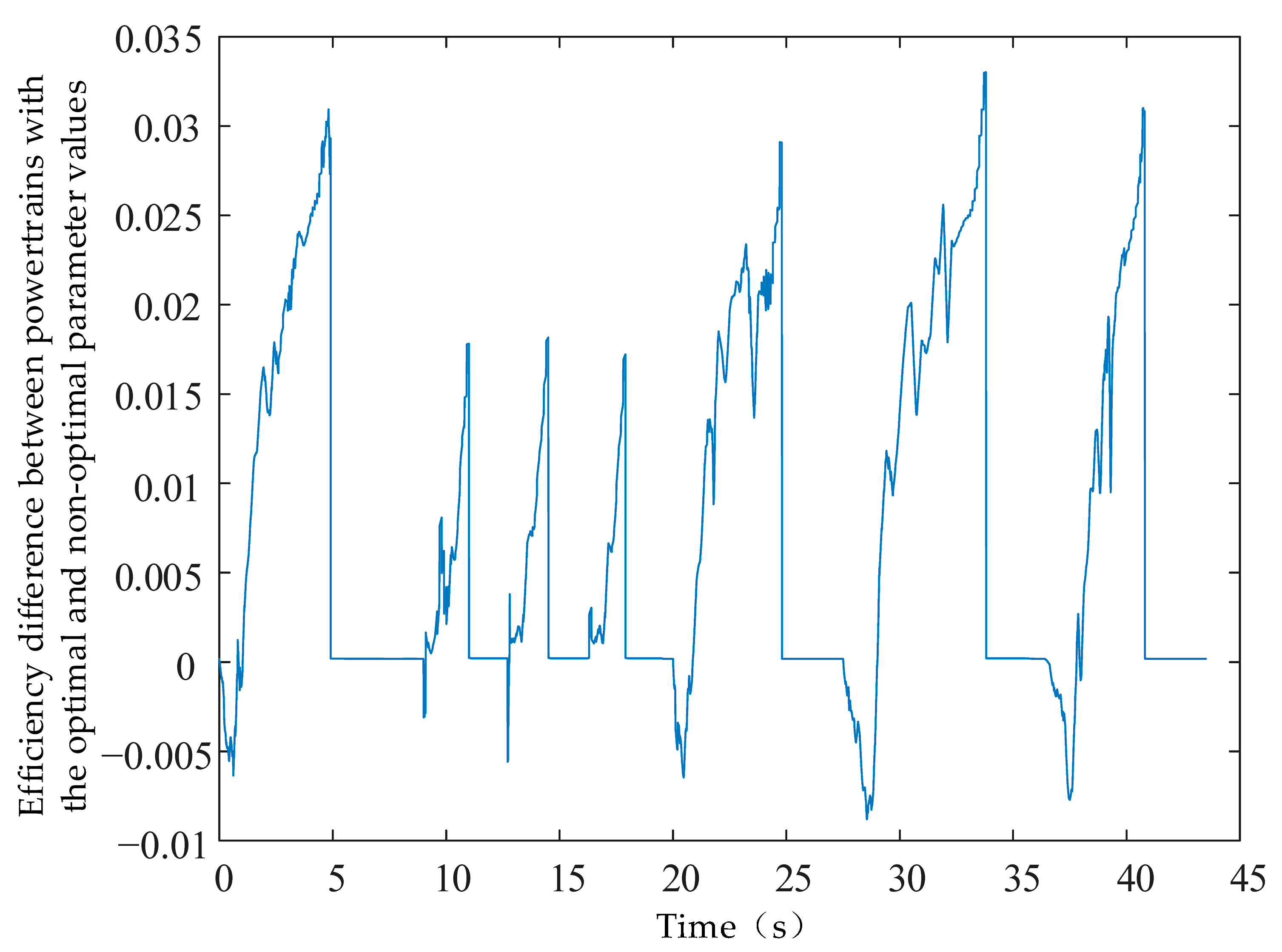
| Parameter | Value |
|---|---|
| Vehicle mass (kg) | 32,300 |
| Rated Load (kg) | 5000 |
| Vehicle frontal area (m2) | 4.5 |
| Drag coefficient | 0.7 |
| Engine rated power (kW) | 238.8 |
| Engine peak torque (N·m) | 1369 |
| PGS ratio | 2.3 |
| Speed ratio of the fixed-ratio gear mechanism | 1 |
| First gear ratio of range transmission | 4.18 |
| Second gear ratio of range transmission | 1.96 |
| Third gear ratio of range transmission | 0.81 |
| Final drive ratio | 4.5 |
| Wheel reducers ratio | 4.6 |
| Wheel radius (m) | 0.83 |
| Material Types | Density (t/m3) |
|---|---|
| Ordinary soil | 1.6~2.0 |
| Clay | 1.8~2.0 |
| Fine sand | 1.6~1.8 |
| Gravel | 2.6~2.9 |
| Large stone | 2.2~3.5 |
| Variable | Measurement Points | Sensor Types | Range | Accuracy |
|---|---|---|---|---|
| Engine speed (rpm) | Flywheel | Hall-effect | 0~3000 | −0.8%~0.6% |
| Gearbox output speed (rpm) | Speed measurement port | Hall-effect | −4000~4000 | −0.5%~0.5% |
| Gearbox output torque (N·m) | Gearbox output shaft | Non-contact | 0~10,000 | −0.03%~0.05% |
| Brake cylinder stroke (mm) | Two ends of the cylinder | String | 0~20 | ±0.25% |
| Working pump outlet pressure (MPa) | Pressure port | Piezoelectric | 0~20 | −0.1%~0.1% |
| Steering pump outlet pressure (MPa) | Pressure port | Piezoelectric | 0~20 | −0.1%~0.1% |
| Outlet pressure of the brake master cylinder (MPa) | Pressure port | Piezoelectric | 0~20 | −0.08%~0.05% |
| Cooling pump outlet pressure (MPa) | Pressure port | Piezoelectric | 0~20 | −0.07%~0.1% |
| Boom cylinder bore pressure (MPa) | Pressure port | Piezoelectric | 0~20 | −0.15%~0.15% |
| Boom cylinder rod pressure (MPa) | Pressure port | Piezoelectric | 0~20 | −0.08%~0.1% |
Disclaimer/Publisher’s Note: The statements, opinions and data contained in all publications are solely those of the individual author(s) and contributor(s) and not of MDPI and/or the editor(s). MDPI and/or the editor(s) disclaim responsibility for any injury to people or property resulting from any ideas, methods, instructions or products referred to in the content. |
© 2025 by the authors. Licensee MDPI, Basel, Switzerland. This article is an open access article distributed under the terms and conditions of the Creative Commons Attribution (CC BY) license (https://creativecommons.org/licenses/by/4.0/).
Share and Cite
Liu, X.; Liu, C.; Pan, C. Parameter Optimization Design of Power-Cycling Hydrodynamic Mechanical Transmission Based on Output Capacity Characteristics. Energies 2025, 18, 5703. https://doi.org/10.3390/en18215703
Liu X, Liu C, Pan C. Parameter Optimization Design of Power-Cycling Hydrodynamic Mechanical Transmission Based on Output Capacity Characteristics. Energies. 2025; 18(21):5703. https://doi.org/10.3390/en18215703
Chicago/Turabian StyleLiu, Xiaojun, Changzhao Liu, and Chunyang Pan. 2025. "Parameter Optimization Design of Power-Cycling Hydrodynamic Mechanical Transmission Based on Output Capacity Characteristics" Energies 18, no. 21: 5703. https://doi.org/10.3390/en18215703
APA StyleLiu, X., Liu, C., & Pan, C. (2025). Parameter Optimization Design of Power-Cycling Hydrodynamic Mechanical Transmission Based on Output Capacity Characteristics. Energies, 18(21), 5703. https://doi.org/10.3390/en18215703






